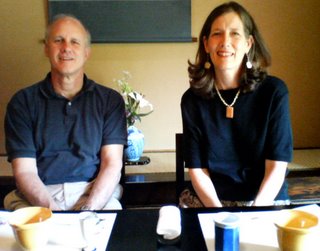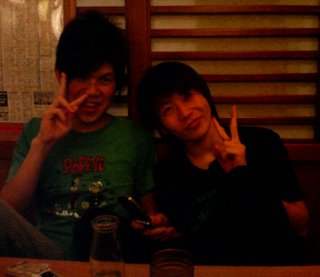
THIS MAY be my favorite ad of all time. Unfortunately, my picture has bad lighting (it was on the subway wall) but the lighting in the picture itself is awesome. And there's so much bound up in the characters' faces.
Photo journal. Current location: Beijing







 OK, let me introduce my bosses (I have three of them, sort of): Masa, Jun, and Yoshi (left to right). Yoshi hired me, Masa is my navigator, and Jun laughs at my jokes once in awhile. They're all great people to work with, and I'm sure they'll make cameos throughout this blog.
OK, let me introduce my bosses (I have three of them, sort of): Masa, Jun, and Yoshi (left to right). Yoshi hired me, Masa is my navigator, and Jun laughs at my jokes once in awhile. They're all great people to work with, and I'm sure they'll make cameos throughout this blog.




 My friends Haruna (holding chopsticks) and Sayuri, and Uchi (not pictured) prepared a delicious farewell dinner for me in a friend's apartment. The main course was chirashizushi. Imagine a bed of rice with snow peas, small slices of sashimi, sugar, and egg on top. It doesn't get any better.
My friends Haruna (holding chopsticks) and Sayuri, and Uchi (not pictured) prepared a delicious farewell dinner for me in a friend's apartment. The main course was chirashizushi. Imagine a bed of rice with snow peas, small slices of sashimi, sugar, and egg on top. It doesn't get any better. This is Kenji, a college outreach staff member, looking his best. His English is very good and he often translates for me if I talk myself into a corner. Kenji and Channing also attended the dinner party. The background is a typical college apartment. What you see in the picture is about 25% of the entire living space, including the kitchen.
This is Kenji, a college outreach staff member, looking his best. His English is very good and he often translates for me if I talk myself into a corner. Kenji and Channing also attended the dinner party. The background is a typical college apartment. What you see in the picture is about 25% of the entire living space, including the kitchen. Dan and Carol are my host-parents. Dan is the Chiba team leader, English teacher, Bible-study leader, and pastor of Oyumino Church - for starters. Sometimes I think he gets more work done in a day than I will do in my undergraduate career. Carol is a KCS (soon to be CCSI) teacher and mother of nine kids. She also is very involved in the community. Thank you, Dan and Carol, for putting up with me for a year and being so nice about it :-)
Dan and Carol are my host-parents. Dan is the Chiba team leader, English teacher, Bible-study leader, and pastor of Oyumino Church - for starters. Sometimes I think he gets more work done in a day than I will do in my undergraduate career. Carol is a KCS (soon to be CCSI) teacher and mother of nine kids. She also is very involved in the community. Thank you, Dan and Carol, for putting up with me for a year and being so nice about it :-) It was a typical Sunday morning. I arrived at church a few minutes late for my Bible study at Honda Chapel, set up a few chairs, and tried without much luck to decode the Japanese sermon. (One nice thing is that many of the praise songs are in hiragana, not kanji, so that younger kids and people like me can pronounce them. This way I'm able to sing most of the songs in church, which is nice, even if I'm not certain of their meaning.) During the announcements, Nagata-san told congregation that I would be leaving. "Peetah-kun.... America ni kaerimasu...sui-yobi.... etc." Then before I realized it, he invited everyone to sento that night to see me off!
It was a typical Sunday morning. I arrived at church a few minutes late for my Bible study at Honda Chapel, set up a few chairs, and tried without much luck to decode the Japanese sermon. (One nice thing is that many of the praise songs are in hiragana, not kanji, so that younger kids and people like me can pronounce them. This way I'm able to sing most of the songs in church, which is nice, even if I'm not certain of their meaning.) During the announcements, Nagata-san told congregation that I would be leaving. "Peetah-kun.... America ni kaerimasu...sui-yobi.... etc." Then before I realized it, he invited everyone to sento that night to see me off! That's about it. I may post a few more photos when I get back to the states, but Nashi Fruit is ending. This summer I'm continuing my Japanese studies at Stanford University and will be attending Georgetown University in the Fall. Thanks for watching!
That's about it. I may post a few more photos when I get back to the states, but Nashi Fruit is ending. This summer I'm continuing my Japanese studies at Stanford University and will be attending Georgetown University in the Fall. Thanks for watching!
 These pictures are from Ueno park. I was really impressed with how the lantern (?)...indwelt.... the tree behind it in this picture. The branches are just where the artist went a little crazy, or where he gave his sculpture an organic halo.
These pictures are from Ueno park. I was really impressed with how the lantern (?)...indwelt.... the tree behind it in this picture. The branches are just where the artist went a little crazy, or where he gave his sculpture an organic halo.









 And this one. You always find interesting stores off the main drag. Tintin books, Tintin TV shows, but most awesomely, Tintin and Snowy figurines, two of which I bought.
And this one. You always find interesting stores off the main drag. Tintin books, Tintin TV shows, but most awesomely, Tintin and Snowy figurines, two of which I bought.
Yokohama and Chiba college outreach teams arose with the sun Wednesday morning. They headed north - by van or by train - to Nagano prefecture for a three day snow camp. I entrusted my life – what choice did I have? - to Nagata's ancient Toyota mini-van for the four hour trip. In my car were Yuko, Hajime, Nagata, and myself. None of them spoke fluent English, so I thrust my beginner Japanese on the lot of them.
Me: Where are we going?
Nagata: We are going to Nagano.
Me: What are we going to do?
Yuko: We are going to ski.
Me: Is that so? How many children do you have? (etc, etc)
The Japanese countryside was very beautiful, even through a dirty van window. It's interesting how a few places in Japan, like Tokyo and Nagoya, can be so crowded, while vast stretches of green in other parts of the country only boast a few houses and farms. Location, location, location.
~
I get carsick in Japanese vans, I'm not sure why.
~
Snow Camp was a very memorable experience. I was the only person there who spoke fluent English. This proved initially frustrating, but by the end I felt exhilarated because of all the Japanese I had learned. The ski resort didn't have snowboard boots in my size (they stopped about 7 cm shorter) so I tried skis for the first time. By the end of the day I was poling my way around with relative ease, although I wished I had learned more Japanese curse words when I attempted a mogul run.
~
Here is a picture of Shinya leading worship in the evening. Next is a snapshot of the group before we went our separate ways. I made a lot of friends that week, had many interesting conversations with people even with my limited vocabulary.


